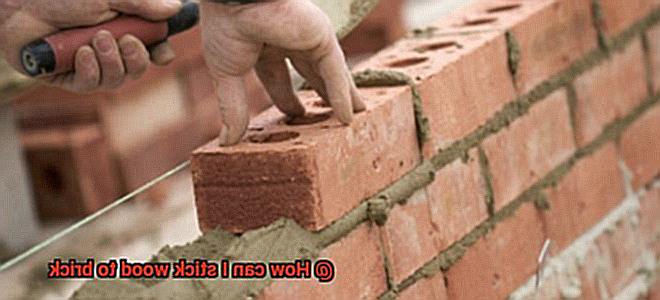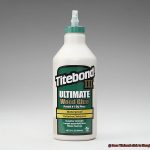Hey there, fellow DIY enthusiasts.
Contents
- 1 What You Need to Know Before Sticking Wood to Brick
- 2 Different Adhesives for Bonding Wood and Brick
- 3 Preparing the Surfaces for Adhesive Application
- 4 Applying the Adhesive Properly
- 5 Securing the Wood with Mechanical Fasteners
- 6 Using a Combination of Adhesive and Mechanical Fasteners
- 7 Factors that Affect Bond Strength
- 8 Tips for Ensuring a Strong Bond
- 9 Conclusion
Today, we’re diving into a question that’s bound to come up sooner or later in your home improvement journey: “How can I stick wood to brick?” Whether you’re looking to jazz up your living room with some sleek wooden shelves or dreaming of adding a rustic touch with a wooden accent wall, we’ve got the answers you need.
In this post, we’ll guide you through foolproof methods to ensure that wood and brick become BFFs forever. From the magic of construction adhesives to the wonders of masonry anchors, we’ll spill all the secrets while keeping things simple and straightforward.
So let’s get ready to make those wood and brick surfaces stick together like glue.
What You Need to Know Before Sticking Wood to Brick
Sticking wood to brick may seem like a daunting task, but with the right knowledge and preparation, it can be accomplished with ease. Whether you’re looking to add a touch of rustic charm to your brick walls or create functional furniture, understanding the key considerations and steps is essential. In this article, we will explore expert-level insights to help you successfully stick wood to brick.
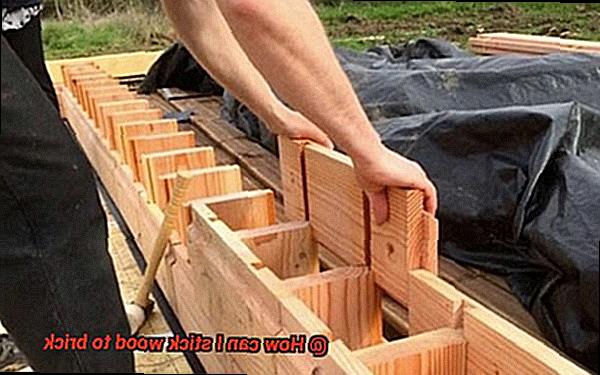
Consider the type and condition of the wood and brick:
Moisture content:
Surface preparation:
Choosing the right adhesive:
Test the adhesive:
Proper installation:
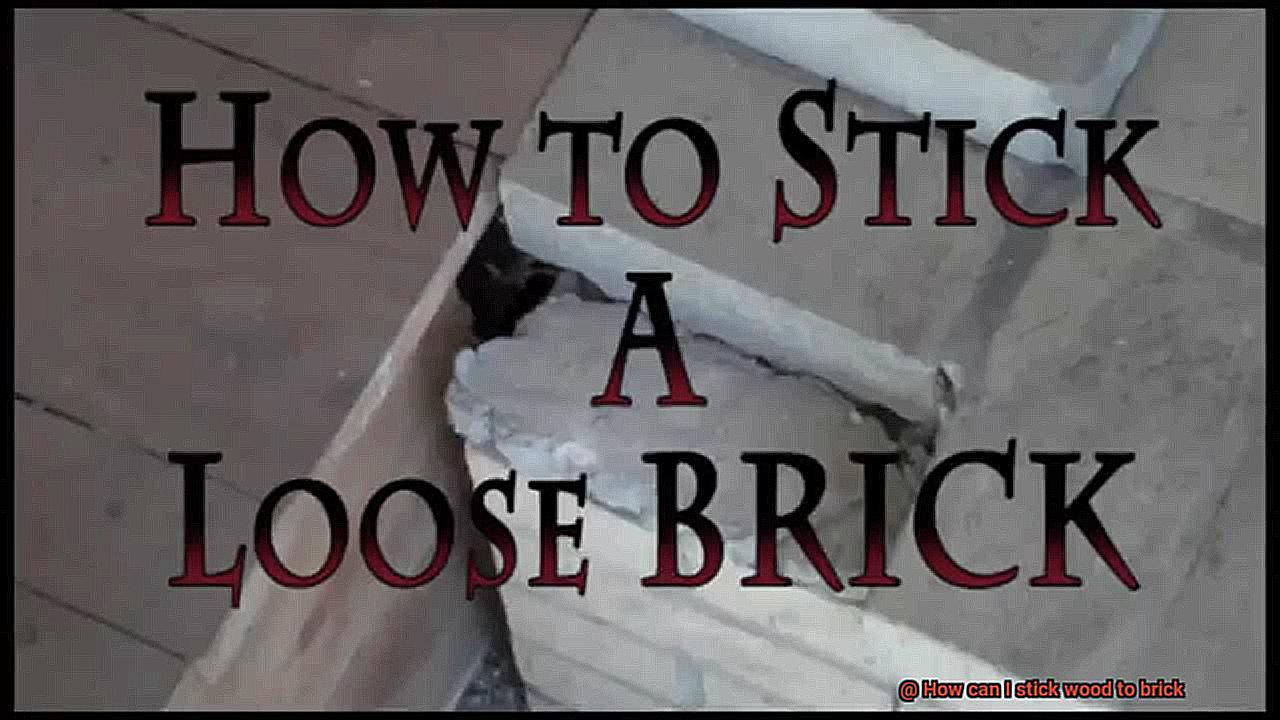
Different Adhesives for Bonding Wood and Brick
When it comes to bonding wood to brick, choosing the right adhesive is crucial for a strong and long-lasting bond. Luckily, there are several different adhesives available, each with its own unique strengths and weaknesses.
Construction adhesive is a popular choice for bonding wood to brick. This versatile adhesive offers excellent bonding strength and can withstand extreme temperatures and weather conditions. Applied using a caulking gun, construction adhesive comes in a tube and requires curing time before reaching its full strength.
For a strong and durable bond, epoxy is an excellent option. Consisting of a resin and a hardener, when mixed together, epoxy creates a bond that is resistant to water, chemicals, and temperature fluctuations. While it may have a longer curing time compared to other adhesives, the patience is well worth it for high-strength applications.

If flexibility and moisture resistance are important factors for your project, consider using polyurethane adhesive. This versatile adhesive provides excellent bonding strength and flexibility, making it ideal for bonding wood to brick. Just be sure to allow sufficient curing time for the adhesive to reach its full strength.
Silicone adhesive is known for its flexibility and moisture resistance. While it may not provide the same level of bonding strength as other adhesives, it can still be suitable for certain projects. Look for a silicone adhesive specifically designed for bonding wood and brick.
Lastly, Liquid Nails is a popular brand of construction adhesive commonly used for bonding wood to various surfaces, including brick. It offers a durable bond and comes in a convenient tube for easy application.
Preparing the Surfaces for Adhesive Application
Preparing surfaces for adhesive application is crucial for achieving a strong and long-lasting bond between wood and brick. To ensure success, follow these steps:
- Cleanliness: Start by wiping down both surfaces with a damp cloth or sponge to remove dust, dirt, grease, and other contaminants. For stubborn stains, use a mild detergent solution, but rinse it off thoroughly and allow the surfaces to dry completely.
- Roughen the surfaces: Lightly sand both the wood and brick surfaces using fine-grit sandpaper. This creates a rough texture that enhances adhesive grip. After sanding, remove any dust or debris with a clean cloth or brush.
- Prime or seal: Apply a primer or sealer suitable for both wood and brick to prevent moisture absorption by porous materials like brick. This creates a barrier between the surface and adhesive, ensuring better adhesion and durability. Follow the manufacturer’s instructions for application and drying time.
- Check alignment: Before applying adhesive, ensure that both surfaces are level and properly aligned. This ensures an even bond between wood and brick.
- Choose the right adhesive: Select an adhesive specifically designed for wood-to-brick bonding. Options include construction adhesive, epoxy, polyurethane adhesive, silicone adhesive, and Liquid Nails. Follow the manufacturer’s instructions for application, drying times, and curing processes.
Remember to test the adhesive on a small, inconspicuous area before applying it to the entire surface to ensure compatibility and desired results.
Applying the Adhesive Properly
Embark on an exciting bonding adventure that combines the strength of wood with the sturdiness of brick. In this comprehensive guide, we will explore the necessary steps to apply adhesive properly when sticking wood to brick. From the importance of cleanliness to the patience required for curing, we’ve got you covered. So, grab your tools and get ready to dive into the world of adhesive magic.
Step 1: Cleanliness is Key
Just like a warrior’s armor, both wood and brick surfaces must be pristine. Banish any unruly particles by giving them a quick swipe with a brush or cloth. This ensures that the battleground is prepared for the epic bond that awaits.
Step 2: Choosing the Right Adhesive
With a wide array of adhesives at your disposal, it’s essential to select one specifically designed for bonding wood to brick. Construction adhesive, epoxy, or polyurethane adhesive are popular choices. Each type possesses unique properties and strengths, so choose wisely based on your specific needs.
Step 3: Test Run
Before diving headfirst into battle, perform a test application on a small, inconspicuous area. This step ensures compatibility and adhesion, providing peace of mind before proceeding. Depending on the results, additional surface preparation or priming may be required.
Step 4: Apply Evenly and Generously
Now it’s time to wield your adhesive weapon. Apply the chosen adhesive evenly and generously onto the wood surface. Follow the manufacturer’s instructions regarding application technique and coverage area. In certain cases, applying adhesive to both surfaces may be necessary for optimal adhesion.
Step 5: Align with Precision
Imagine warriors forming a united front before charging into battle. Similar precision is required when aligning the wood accurately with the desired position on the brick surface. Hold it firmly in place for a few minutes to allow the adhesive to bond properly. For added support, consider using clamps or braces during the curing process.
Step 6: Patience is a Virtue
As warriors wait for the perfect moment to strike, you must allow sufficient curing time for the adhesive bond to strengthen. Leave the wood-to-brick alliance undisturbed for at least 24 hours, or follow the specific curing guidelines provided by the manufacturer. Remember, patience will lead to a strong and resilient bond.
Securing the Wood with Mechanical Fasteners
In this comprehensive guide, we will delve into the intricacies of this process, equipping you with invaluable tips and tricks along the way. So, prepare to be captivated as we embark on this thrilling adventure.
Securing Wood to Brick with Mechanical Fasteners:
The Right Fasteners for the Job:
- Opt for stainless steel screws or nails to ensure long-lasting durability.
- Choose the appropriate length to penetrate both the wood and brick effectively, forming a secure and steadfast bond.
Preparing for Attachment:
- Safeguard against splitting by drilling pilot holes in the wood.
- Utilize a masonry drill bit that matches the diameter of your chosen screws or nails.
Aligning and Attaching with Precision:
- Mark hole positions on both wood and brick before drilling, ensuring accurate alignment.
- Guarantee a flush fit between the wood and wall for a seamless finish.
- Drive screws or nails through pre-drilled holes with precision and care.
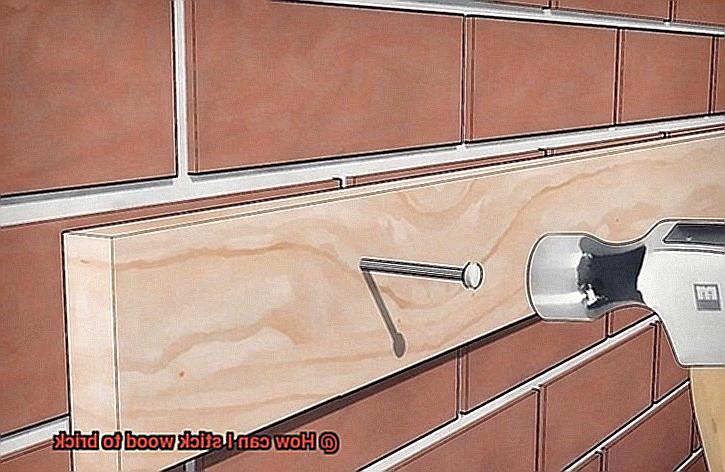
Exploring an Alternative: The Power of Adhesive Glue:
Selecting the Perfect Adhesive:
- Choose a high-quality adhesive specifically designed for bonding wood and brick.
- Ensure the product is suitable for exterior applications, providing longevity in all weather conditions.
Surface Preparation for Optimal Bonding:

Applying Adhesive Like a Pro:
- Follow the manufacturer’s instructions meticulously when mixing and applying the adhesive.
- Utilize a notched trowel or an appropriate applicator to distribute an even layer of adhesive across both surfaces.
Achieving a Mighty Bond:
- Press the wood firmly against the brick, aligning it flawlessly.
- Apply consistent pressure to ensure an unyielding bond.
- Allow ample curing time as per the adhesive manufacturer’s instructions, fostering a robust connection.
Using a Combination of Adhesive and Mechanical Fasteners
Whether you’re embarking on a DIY project or tackling a professional construction job, this powerful duo ensures that your wood stays firmly attached to the brick surface. In this guide, we will explore the steps involved in using adhesive and mechanical fasteners to create a secure and long-lasting bond between wood and brick.
Choosing the Right Adhesive:
Before diving into the nitty-gritty, it’s crucial to select the appropriate adhesive. Construction adhesive, epoxy, and polyurethane adhesive are all excellent options specifically designed for bonding wood to masonry surfaces. These adhesives provide the strength and durability necessary for a successful bond.
Preparation is Key:
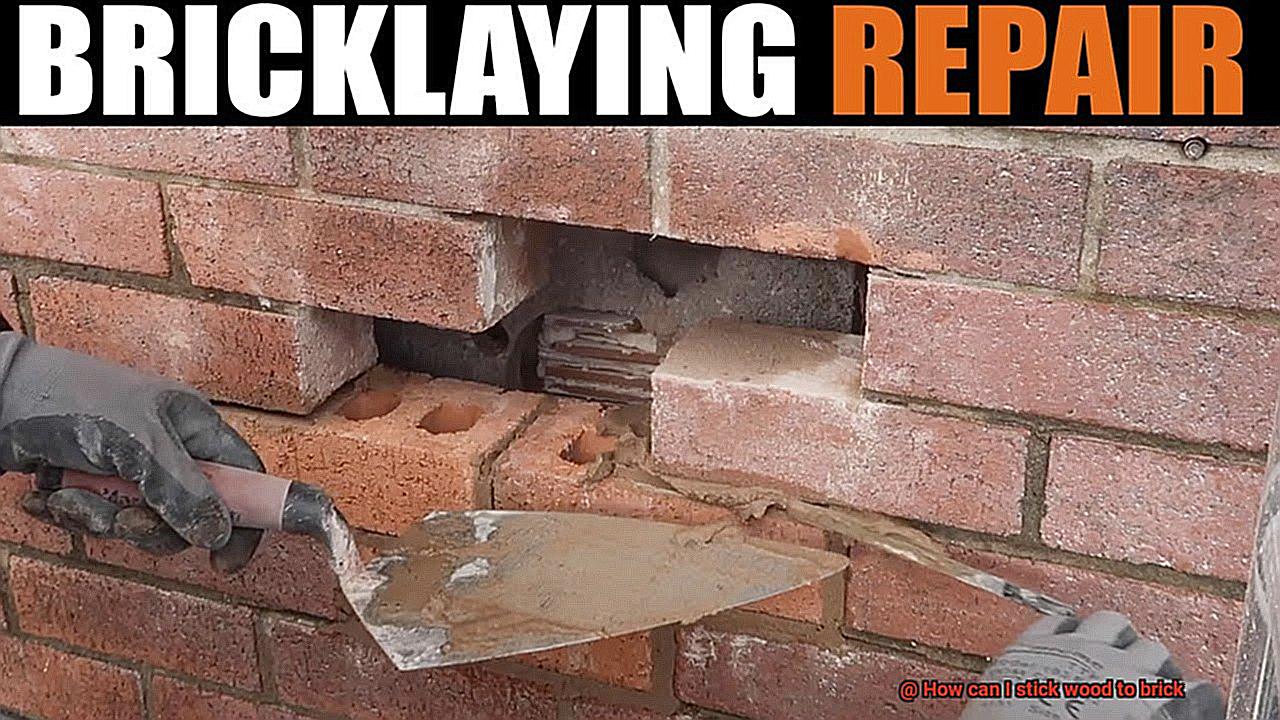
To ensure optimal adhesion, thorough preparation of the brick surface is essential. Begin by removing any dirt, dust, or loose particles using a stiff brush or a pressure washer for a deep clean. To enhance adhesion, roughen the surface by sanding or using a wire brush.
Applying the Adhesive:
Once the brick surface is prepared, it’s time to apply the adhesive. Follow the manufacturer’s instructions precisely. Apply the adhesive in a zigzag pattern on the back of the wood, ensuring complete coverage over the entire contact area with the brick.
Pressing and Curing:
Now comes the moment of truth – pressing the wood against the brick surface. Apply even pressure to achieve a strong bond. For uniform distribution of pressure, use clamps or weights on top of the wood piece. Allow sufficient time for the adhesive to dry and cure according to the manufacturer’s instructions.
Enhancing Strength with Mechanical Fasteners:
While adhesive alone provides strength, incorporating mechanical fasteners takes it up a notch. Screws or nails compatible with both wood and brick can reinforce the bond even further. To prevent wood splitting or cracking, pre-drill holes in the wood before inserting fasteners. Make the holes slightly smaller than the fastener diameter to ensure a tight fit.
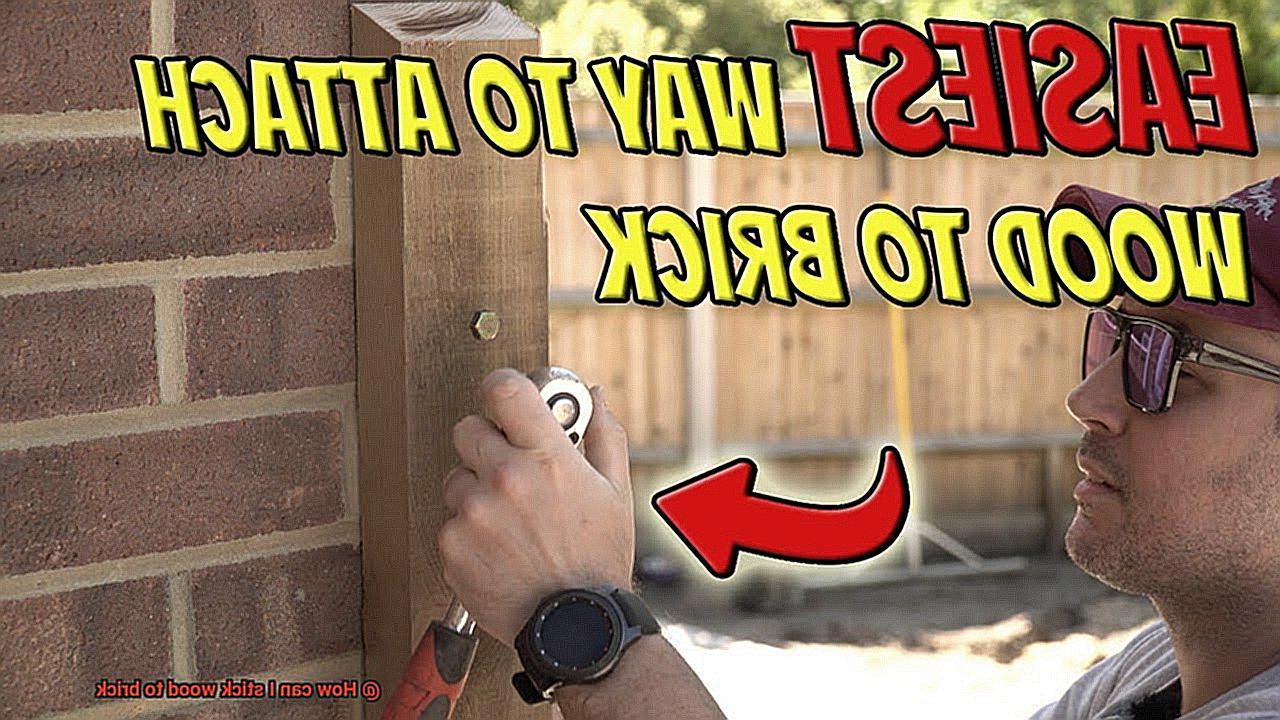
Driving It Home:

With everything in place, it’s time to drive the fasteners into the pre-drilled holes. Use a screwdriver or a hammer, ensuring that the fasteners are driven straight and flush with the wood surface for a clean finish.
The Power of Combination:
By combining adhesive and mechanical fasteners, you create a bond that can withstand heavy loads and provide unparalleled stability. The adhesive ensures a strong initial attachment, while the mechanical fasteners act as an extra layer of reinforcement. This combination is particularly beneficial for load-bearing structures or applications where longevity is key.
Factors that Affect Bond Strength
When it comes to bonding wood to brick, achieving a strong and reliable bond is essential. The bond strength can be influenced by several factors, including surface preparation, adhesive selection, and environmental conditions.
Surface preparation is a crucial step in ensuring a strong bond between wood and brick. Both surfaces should be thoroughly cleaned and free from any dirt, dust, grease, or loose particles that could hinder the bond. Any existing paint or coating should be removed to allow for direct contact between the wood and brick. To enhance the bond strength, roughening the surfaces through sanding or scoring can create more surface area for the adhesive to grip onto.
The selection of the right adhesive is equally important in achieving a strong bond. Polyurethane-based adhesives are commonly used for bonding wood to brick due to their excellent bonding strength and resistance to moisture. These adhesives provide a reliable and long-lasting connection. Another option is epoxy adhesives, known for their high strength and durability. It’s crucial to choose an adhesive specifically formulated for bonding wood to masonry surfaces to ensure optimal results.
Environmental conditions also play a significant role in bond strength. Temperature and humidity levels can impact the curing process of adhesives. It is essential to follow the manufacturer’s recommendations regarding temperature range during application, as extreme temperatures can affect the performance of the adhesive. Additionally, high humidity can prolong the curing time, while low humidity can cause the adhesive to cure too quickly, compromising the bond strength. Maintaining suitable environmental conditions during the bonding process is crucial for achieving a strong and durable bond.
Tips for Ensuring a Strong Bond
When it comes to sticking wood to brick, ensuring a strong bond is crucial for the success and durability of your project. Whether you’re building outdoor furniture or creating decorative accents, following these eight tips will help you achieve a reliable bond that will withstand the test of time.
Clean the surfaces:
Start by thoroughly cleaning both the brick and wood surfaces. Use a stiff brush or a vacuum cleaner to remove any dirt, dust, or debris. A clean surface provides a better foundation for the adhesive, allowing it to bond directly with the materials.
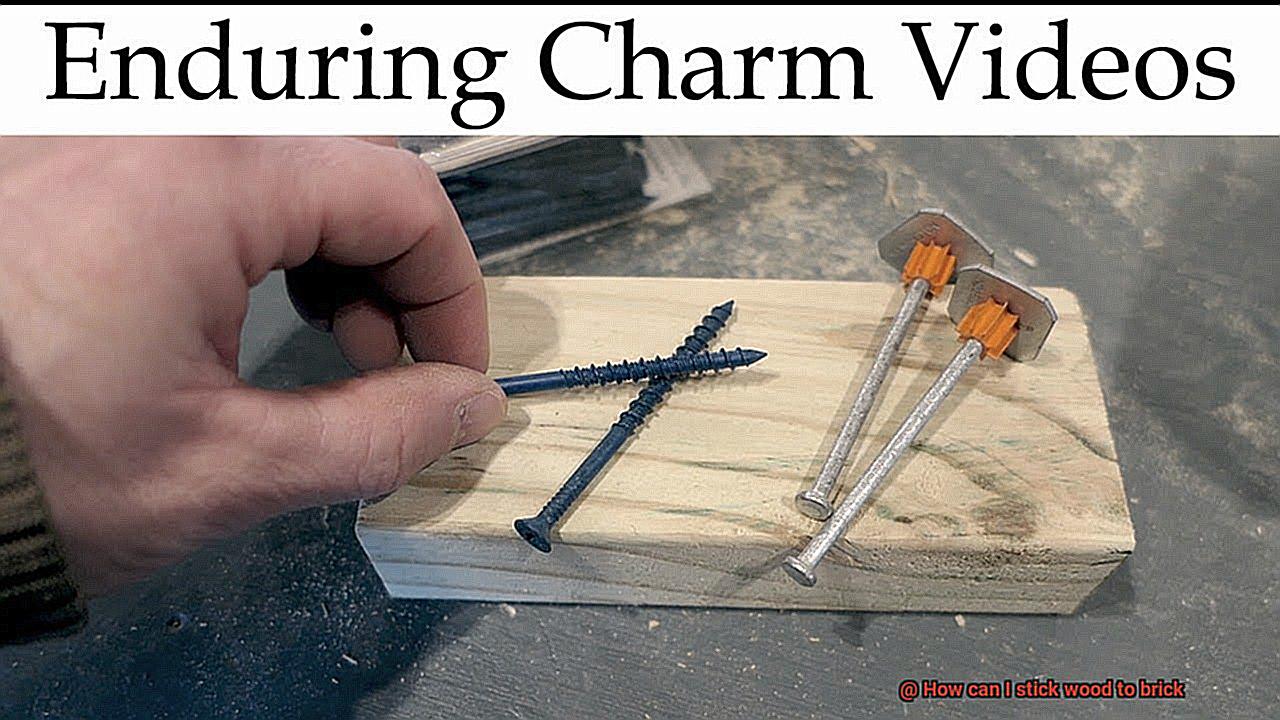
Use the right adhesive:
Choosing the correct adhesive is essential for a strong bond. Consider factors such as the weight of the wood and exposure to outdoor elements when selecting an adhesive. Construction adhesive, epoxy, or polyurethane adhesive are popular choices for sticking wood to brick.
Apply adhesive evenly:
Once you have chosen the appropriate adhesive, apply it evenly on both the wood and brick surfaces using a caulk gun or a trowel. Follow the manufacturer’s instructions regarding the amount and method of application. Avoid applying excessive amounts of adhesive, as it can lead to messy results and weaken the bond.
Create a firm connection:
After applying the adhesive, firmly press the wood against the brick surface. Applying pressure ensures maximum contact between the two surfaces and promotes a stronger bond. Use clamps or heavy objects to hold the wood in place while the adhesive sets.
Allow sufficient curing time:
Patience is key when it comes to achieving a strong bond between wood and brick. Allow ample time for the adhesive to cure before subjecting it to any stress or load. Follow the recommended curing time provided by the adhesive manufacturer, as it may vary depending on the type of adhesive used.
Consider mechanical fasteners:
In addition to using adhesive, consider using mechanical fasteners like screws or nails to enhance the bond between wood and brick. This can provide additional support and stability, especially in high-stress areas. Pre-drill holes into the wood and then attach it to the brick using appropriate fasteners.

Protect against moisture:
Moisture can weaken the bond between wood and brick over time. Take necessary precautions to protect the bonded surfaces from water exposure. This may involve sealing the wood with a waterproofing agent or applying a protective coating to the brick.
Regular maintenance:
To ensure a long-lasting bond, perform regular inspections and maintenance. Check for any signs of damage or deterioration and address them promptly. By maintaining the bond between wood and brick, you can prevent potential issues and prolong its lifespan.
91aKz0_thRM” >
Conclusion
When it comes to sticking wood to brick, there are a few effective methods you can try.
First and foremost, using construction adhesive specifically designed for bonding wood and masonry surfaces is a reliable option. This strong adhesive creates a lasting bond that can withstand the test of time.
Another technique is using masonry screws or anchors to secure the wood to the brick, providing additional support and stability. Additionally, utilizing epoxy resin or polyurethane glue can be an excellent choice for bonding wood and brick together.
Remember to thoroughly clean and prepare both the wood and brick surfaces before applying any adhesive for optimal results.

